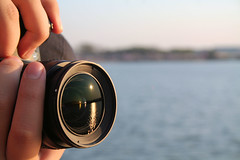Photographing artifacts
Conditions when photographing at Library and Archives Canada
- Confirm with the archivist that photographing the artifact is permissible.
- The camera must be secure to one's neck or wrist by means of a strap, or be mounted on a tripod (depending on which collection and room you are viewing, you may use LAC's copystand or borrow a tripod that can be used on the table). The camera flash must be disabled.
- LAC staff may ask to see the photographs. To allow easy identification of material by LAC staff, keep archival box slip with item to be photographed. LAC provides small strips of paper on which you can mark the fond and box, or item number, which you can place next to the document when photographing it.
Conditions when photographing at the University of Ottawa Archives
- A reproduction form must be signed before the reproduction takes place. All reproductions must be made in compliance with the Canadian Copyright Act. Preservation requirements supersede reproduction needs at all times.
- Reproduction devices such as camera, cell phone, etc. are allowed without the use of a flash.
- Photocopies: $0.25 per page
Other tips
- Set the camera to take the highest resolution image possible.
- If possible, take a photograph of the entire artifact. If there are interesting details you wish to highlight, consider zooming in with your camera.
- Avoid distortions by keeping the camera level with the artifact.
- Check to make sure that the photograph is in focus by zooming in the image when viewing it on the camera.
Borrowing Multimedia Equipment
To borrow multimedia equipment at the Teaching and Learning Support Services - Loans and rentals counter, located at Morisset Hall, room 06, you must first reserve equipment, preferably in person or by phone at 613 562-5900 or 613 562-4616, 24 hours prior to pick-up. Ask for a photo camera and tripod. The Canon SLR will render a better quality photo though there is also a small Kodak point-and-shoot camera available. Ask staff for assistance, including how to disable the flash. You will be required to provide your course code and show your student card. Loans are for 3 days and may be renewed once.
Scanning documents
Media Centre scanning stations
There are two computer stations with the following high resolution scanners located in Media Centre (MRT155):
- A tabloid-size flatbed scanner
- A letter-size flatbed scanner which may be used for transparencies.
- A Nikon 35mm film and slide scanner
To reserve a station, contact Media Centre on the first floor of Morisset Library in person, by phone at 613 562-5723 or by email at libmedia@uottawa.ca. Imaging software and training is provided.
Other scanning devices at the Morisset Library
- Photocopiers: The scans are saved to a USB flash drive or emailed.
- book2net Kiosk (MRT142): Specifically designed to scan books, the scans are saved to a USB flash drive
Scanning Tips
- Choose the scanning format (pdf, Jpeg, Tiff)
- Choose the designed image quality
- Choose the appropriate resolution
- Opt for OCR (Optical character recognition which enables the document to be readable and keyword searchable)
Help
Contact Roxanne Lafleur at the Media Library in Morisset Library (MRT155). Phone: 613 562-5800 ext. 3720
Resources
- Digital Image Size and NameLearn about pixel dimensions, resolution, document size, and recommended practices, including resizing, naming and storing your image files.
- Epson GT-15000 scanner GuideInstruction on how to use the flatbed scanner at Media Centre and how to resize and reformat your image files.
